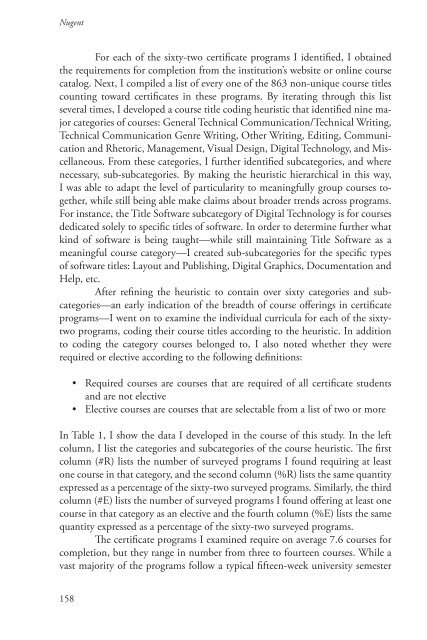Design Discourse- Composing and Revising Programs in Professional and Technical Writing, 2010a
Design Discourse- Composing and Revising Programs in Professional and Technical Writing, 2010a
Design Discourse- Composing and Revising Programs in Professional and Technical Writing, 2010a
Create successful ePaper yourself
Turn your PDF publications into a flip-book with our unique Google optimized e-Paper software.
Nugent<br />
For each of the sixty-two certificate programs I identified, I obta<strong>in</strong>ed<br />
the requirements for completion from the <strong>in</strong>stitution’s website or onl<strong>in</strong>e course<br />
catalog. Next, I compiled a list of every one of the 863 non-unique course titles<br />
count<strong>in</strong>g toward certificates <strong>in</strong> these programs. By iterat<strong>in</strong>g through this list<br />
several times, I developed a course title cod<strong>in</strong>g heuristic that identified n<strong>in</strong>e major<br />
categories of courses: General <strong>Technical</strong> Communication/<strong>Technical</strong> Writ<strong>in</strong>g,<br />
<strong>Technical</strong> Communication Genre Writ<strong>in</strong>g, Other Writ<strong>in</strong>g, Edit<strong>in</strong>g, Communication<br />
<strong>and</strong> Rhetoric, Management, Visual <strong>Design</strong>, Digital Technology, <strong>and</strong> Miscellaneous.<br />
From these categories, I further identified subcategories, <strong>and</strong> where<br />
necessary, sub-subcategories. By mak<strong>in</strong>g the heuristic hierarchical <strong>in</strong> this way,<br />
I was able to adapt the level of particularity to mean<strong>in</strong>gfully group courses together,<br />
while still be<strong>in</strong>g able make claims about broader trends across programs.<br />
For <strong>in</strong>stance, the Title Software subcategory of Digital Technology is for courses<br />
dedicated solely to specific titles of software. In order to determ<strong>in</strong>e further what<br />
k<strong>in</strong>d of software is be<strong>in</strong>g taught—while still ma<strong>in</strong>ta<strong>in</strong><strong>in</strong>g Title Software as a<br />
mean<strong>in</strong>gful course category—I created sub-subcategories for the specific types<br />
of software titles: Layout <strong>and</strong> Publish<strong>in</strong>g, Digital Graphics, Documentation <strong>and</strong><br />
Help, etc.<br />
After ref<strong>in</strong><strong>in</strong>g the heuristic to conta<strong>in</strong> over sixty categories <strong>and</strong> subcategories—an<br />
early <strong>in</strong>dication of the breadth of course offer<strong>in</strong>gs <strong>in</strong> certificate<br />
programs—I went on to exam<strong>in</strong>e the <strong>in</strong>dividual curricula for each of the sixtytwo<br />
programs, cod<strong>in</strong>g their course titles accord<strong>in</strong>g to the heuristic. In addition<br />
to cod<strong>in</strong>g the category courses belonged to, I also noted whether they were<br />
required or elective accord<strong>in</strong>g to the follow<strong>in</strong>g def<strong>in</strong>itions:<br />
• Required courses are courses that are required of all certificate students<br />
<strong>and</strong> are not elective<br />
• Elective courses are courses that are selectable from a list of two or more<br />
In Table 1, I show the data I developed <strong>in</strong> the course of this study. In the left<br />
column, I list the categories <strong>and</strong> subcategories of the course heuristic. The first<br />
column (#R) lists the number of surveyed programs I found requir<strong>in</strong>g at least<br />
one course <strong>in</strong> that category, <strong>and</strong> the second column (%R) lists the same quantity<br />
expressed as a percentage of the sixty-two surveyed programs. Similarly, the third<br />
column (#E) lists the number of surveyed programs I found offer<strong>in</strong>g at least one<br />
course <strong>in</strong> that category as an elective <strong>and</strong> the fourth column (%E) lists the same<br />
quantity expressed as a percentage of the sixty-two surveyed programs.<br />
The certificate programs I exam<strong>in</strong>ed require on average 7.6 courses for<br />
completion, but they range <strong>in</strong> number from three to fourteen courses. While a<br />
vast majority of the programs follow a typical fifteen-week university semester<br />
158


















